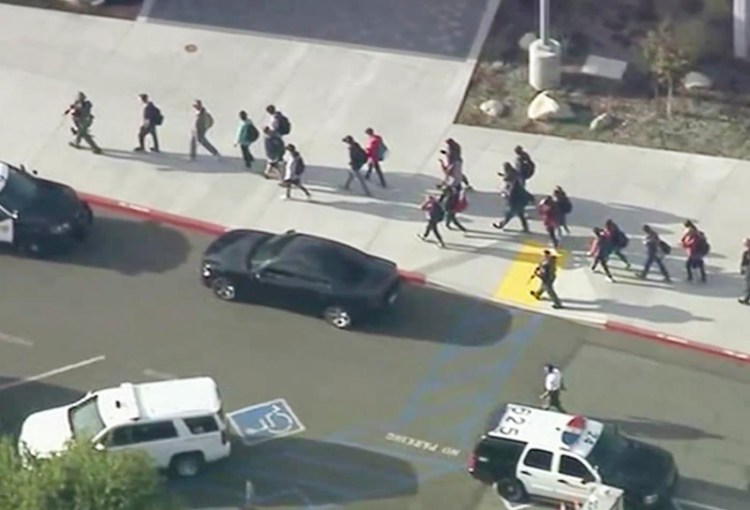Teachers are working hard to educate the next generation, but we are also working to keep students alive. It takes a toll. Here are the steps we are taking to be both trauma-informed and trauma-sensitive. First, some distant background:
When I started teaching, in 1995, I was still taking classes to become certified. In one class, I was asked, “What’s your No. 1 priority as a teacher?”
I replied, “I want to teach my students to read, write and think at the highest possible levels.” All the other teachers in the class said they wanted to provide a safe and supportive environment for students. I thought that was a ridiculously obvious given and too touchy-feely. After all, this was pre-mass shootings, pre-Columbine America.
Now, in 2019, my dismissiveness couldn’t be more wrong. Preventing trauma, identifying trauma and teaching students adversely affected by trauma are central themes in education today.
On the first day of school we had a training on suicide prevention awareness. Teachers were told that if, while talking to a student, “suicide” enters your mind, then ask, “Are you thinking about suicide?”
Later that day, we had a session on recognizing, reporting and preventing abuse: physical, sexual and emotional. The slide show included images of cigarette burns on flesh and red welts from abuse. There were also images of non-abusive injuries. We were taught what to flag and what not to flag.
Two weeks later Rachel’s Challenge came to school with its mission of “making schools safer places where bullying and violence are replaced with kindness and respect.” Rachel Scott was the first person killed in the 1999 Columbine High shooting.
Inspired by her writings, Rachel’s Challenge is a global success about turning tragedy into positive, healing and civic-minded action. It’s a bright phoenix risen from the ashes of trauma.
The day after learning about the mission of Rachel’s Challenge – spreading compassion for special needs students, new students and other targets of bullies – we had a workshop about adverse childhood experiences. These include experiencing violence; substance abuse in the family; neglect; injury, and, finally, death, suicide or attempted suicide by a family member.
To address the challenges of teaching children with adverse experiences, we learned brain science. Stress causes an increase in the hormone cortisol. Our job is to replace cortisol with oxytocin: the healing, loving and trusting hormone. One presenter said that the knowledge of these brain hormones should replace schools’ mission statements.
The most intense focus on trauma was our ALICE training (Alert, Lockdown, Inform, Counter, Evacuate). This training, which included an enactment of a school shooting, was a corrective to the “code red” protocol. “Code red” meant locking down, hiding and staying put, but carnage has resulted from this limited threat response.
ALICE training teaches fighting back and running to safety. During the enactment, a shooter, armed with a hundred-round Nerf toy machine gun, attempted to shoot up classrooms full of teachers. The teachers had been trained both to throw padded balls at the shooter and to run. The only difference between the images of the running teachers that day and the shocking news footage of students running to safety is that the teachers did not have their hands up or on the backs of their heads.
Near the end of the first quarter, we were invited to attend another trauma-related training called Stop the Bleed. A White House initiative launched in 2015, Stop the Bleed teaches bystanders how to become trained, equipped and empowered to help in a bleeding emergency before professional help arrives. Because most mass shootings are over by the time first responders arrive and because 75 percent of gunshot wounds are survivable, teachers are learning how to save students’ lives. We’ve come a long way since learning how to use an EpiPen to treat reactions to allergens.
Despite all this focus on trauma, teachers continue to work together to prepare students for successful futures. We teach our subject areas, as normal, using best practices. But there’s a new normal: On the few occasions the school staff gets together, as often as not, we are focused on worst-case scenarios. That’s what it means in 2019 to provide a safe, supportive and survivable environment for our students.
Copy the Story LinkSend questions/comments to the editors.



Success. Please wait for the page to reload. If the page does not reload within 5 seconds, please refresh the page.
Enter your email and password to access comments.
Hi, to comment on stories you must . This profile is in addition to your subscription and website login.
Already have a commenting profile? .
Invalid username/password.
Please check your email to confirm and complete your registration.
Only subscribers are eligible to post comments. Please subscribe or login first for digital access. Here’s why.
Use the form below to reset your password. When you've submitted your account email, we will send an email with a reset code.